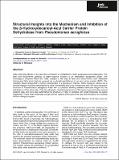Files in this item
Structural insights into the mechanism and inhibition of the beta-Hydroxydecanoyl-Acyl carrier protein dehydratase from pseudomonas aeruginosa
Item metadata
| dc.contributor.author | Moynie, Lucile | |
| dc.contributor.author | Leckie, Stuart M. | |
| dc.contributor.author | McMahon, Stephen A. | |
| dc.contributor.author | Duthie, Fraser G. | |
| dc.contributor.author | Koehnke, Alessa | |
| dc.contributor.author | Taylor, James W. | |
| dc.contributor.author | Alphey, Magnus S. | |
| dc.contributor.author | Brenk, Ruth | |
| dc.contributor.author | Smith, Andrew D. | |
| dc.contributor.author | Naismith, James H. | |
| dc.date.accessioned | 2013-05-03T13:01:02Z | |
| dc.date.available | 2013-05-03T13:01:02Z | |
| dc.date.issued | 2013-01-23 | |
| dc.identifier | 50488441 | |
| dc.identifier | eecc6404-425a-4c7a-9f1b-6873899d78ec | |
| dc.identifier | 000315305700012 | |
| dc.identifier | 84872111212 | |
| dc.identifier.citation | Moynie , L , Leckie , S M , McMahon , S A , Duthie , F G , Koehnke , A , Taylor , J W , Alphey , M S , Brenk , R , Smith , A D & Naismith , J H 2013 , ' Structural insights into the mechanism and inhibition of the beta-Hydroxydecanoyl-Acyl carrier protein dehydratase from pseudomonas aeruginosa ' , Journal of Molecular Biology , vol. 425 , no. 2 , pp. 365-377 . https://doi.org/10.1016/j.jmb.2012.11.017 | en |
| dc.identifier.issn | 0022-2836 | |
| dc.identifier.other | ORCID: /0000-0002-2104-7313/work/36567525 | |
| dc.identifier.other | ORCID: /0000-0002-9353-3716/work/74510017 | |
| dc.identifier.uri | https://hdl.handle.net/10023/3510 | |
| dc.description.abstract | Fatty acid biosynthesis is an essential component of metabolism in both eukaryotes and prokaryotes. The fatty acid biosynthetic pathway of Gram-negative bacteria is an established therapeutic target. Two homologous enzymes FabA and FabZ catalyze a key step in fatty acid biosynthesis; both dehydrate hydroxyacyl fatty acids that are coupled via a phosphopantetheine to an acyl carrier protein (ACP). The resulting trans-2-enoyl-ACP is further polymerized in a processive manner. FabA, however, carries out a second reaction involving isomerization of trans-2-enoyl fatty acid to cis-3-enoyl fatty acid. We have solved the structure of Pseudomonas aeruginosa FabA with a substrate allowing detailed molecular insight into the interactions of the active site. This has allowed a detailed examination of the factors governing the second catalytic step. We have also determined the structure of FabA in complex with small molecules (so-called fragments). These small molecules occupy distinct regions of the active site and form the basis for a rational inhibitor design program. (C) 2012 Elsevier Ltd. All rights reserved. | |
| dc.format.extent | 13 | |
| dc.format.extent | 1531770 | |
| dc.language.iso | eng | |
| dc.relation.ispartof | Journal of Molecular Biology | en |
| dc.subject | Design | en |
| dc.subject | FABZ | en |
| dc.subject | Isomerase | en |
| dc.subject | Helicobacter-pylori | en |
| dc.subject | Antibacterial drug discovery | en |
| dc.subject | Macromolecular crystallography | en |
| dc.subject | Fatty-acid biosynthesis | en |
| dc.subject | Lead discovery | en |
| dc.subject | Crystal-structure characterization | en |
| dc.subject | Diffraction data | en |
| dc.subject | QH301 Biology | en |
| dc.subject.lcc | QH301 | en |
| dc.title | Structural insights into the mechanism and inhibition of the beta-Hydroxydecanoyl-Acyl carrier protein dehydratase from pseudomonas aeruginosa | en |
| dc.type | Journal article | en |
| dc.contributor.sponsor | European Commission | en |
| dc.contributor.institution | University of St Andrews. School of Chemistry | en |
| dc.contributor.institution | University of St Andrews. Biomedical Sciences Research Complex | en |
| dc.contributor.institution | University of St Andrews. School of Biology | en |
| dc.contributor.institution | University of St Andrews. EaSTCHEM | en |
| dc.identifier.doi | 10.1016/j.jmb.2012.11.017 | |
| dc.description.status | Peer reviewed | en |
| dc.identifier.grantnumber | HEALTH-F3-2008-223461 | en |
This item appears in the following Collection(s)
Items in the St Andrews Research Repository are protected by copyright, with all rights reserved, unless otherwise indicated.

